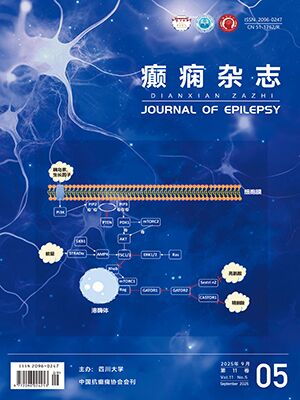| 1. |
Kaindl AM. Antiepileptic drugs and the developing brain. Cell Mol Life Sci, 2006, 63(4):399-413.
|
| 2. |
Hessen E. Influence of major antiepileptic drugs on attention, reaction time, and speed of information processing:results from a randomized, double-blind, placebo-controlled withdrawal study of seizure-free epilepsy patients receiving monotherapy. Epilepsia, 2006, 47(12):2038-2045.
|
| 3. |
Loring DW, Medor KJ. Cognitive side effects of antiepileptic drugs in children. Neurology, 2004, 62(6):872-877.
|
| 4. |
Shih JJ, Ochoa JG. A systematic review of antiepileptic drug initiation and withdrawal. Neurologist, 2009, 15(3):122-131.
|
| 5. |
Berg AT, Shinnar S. Relapse following discontinuation of antiepileptic drugs:a meta-analysis. Neurology, 1994, 44(4):601-608.
|
| 6. |
Verrotti A, Trotta D, Salladini C, et al. Risk factors for recurrence of epilepsy and withdrawal of antiepileptic therapy. Ann Med, 2003, 35(3):207-215.
|
| 7. |
Aktekin B. Withdrawal of antiepileptic drugs in adult patients free of seizures for 4 years:a prospective study. Epilepsy Behav, 2006, 8(3):616-619.
|
| 8. |
Specchio LM, Tramacere L, La Neve A, et al. Discontinuing antiepileptic drugs in patients who are seizure free on. J Neurol Neurosurg Psychiatry, 2002, 72(1):22-25.
|
| 9. |
Specchio LM, Beghi E. Should antiepileptic drugs be withdrawn in seizure-free patients?. CNS Drugs, 2004, 18(4):201-212.
|
| 10. |
Ohta H. Prognosis after withdrawal of antiepileptic drugs in childhood-onset cryptogenic localization-related epilepsies. Brain and Development, 2004, 26(1):19-25.
|
| 11. |
No authors listed. Practice parameter:guideline for discontinuing antiepileptic drugs in. Neurology, 1996, 47(2):600-602.
|
| 12. |
No authors listed. Randomised study of antiepileptic drug withdrawal in patients in remission. Lancet, 1991, 337(8751):1175-1180.
|
| 13. |
Cardoso TA, Coan AC, Kobayashi E, et al. Hippocampal abnormalities and seizure recurrence after antiepileptic drug. Neurology, 2006, 67(1):134-136.
|
| 14. |
Strozzi I, Nolan SJ, Sperling MR, et al. Early versus late antiepileptic drug withdrawal for people with epilepsy in. Cochrane Database Syst Rev, 2015, 11(2):CD001902.
|
| 15. |
Beghi E. Withdrawal of antiepileptic drugs:guidelines of the Italian League Against Epilepsy. Epilepsia, 2013, 54(Suppl 7):2-12.
|
| 16. |
Berg AT, Shinnar S, Levy SR, et al. Two-year remission and subsequent relapse in children with newly diagnosed. Epilepsia, 2001, 42(12):1553-1562.
|
| 17. |
Afshari D, Moradian N. Evaluating the rate of recurrence of epilepsy after therapy discontinuation in 2-year seizure-free epileptic patients. Int J Neurosci, 2012, 122(10):598-601.
|
| 18. |
Incecik F, Herguner OM, Altunbasak SF, et al. Risk of recurrence after discontinuation of antiepileptic drug therapy in. J Pediatr Neurosci, 2014, 9(2):100-104.
|
| 19. |
Li W. Prospective study on the withdrawal and reinstitution of antiepileptic drugs among seizure-free patients in west China. J Clin Neurosci, 2014, 21(6):997-1001.
|
| 20. |
Pavlovic M, Jovic N, Pekmezovic T. Withdrawal of antiepileptic drugs in young patients with cryptogenic focal epilepsies. Seizure, 2012, 21(6):431-436.
|
| 21. |
Su L. Predictors for relapse after antiepileptic drug withdrawal in seizure-free patients with epilepsy. J Clin Neurosci, 2013, 20(6):790-794.
|
| 22. |
Altunbaşak S, Artar O, Burgut RS, et al. Relapse risk analysis after drug withdrawal in epileptic children with. Seizure, 1999, 8(7):384-389.
|
| 23. |
Cendes F. Epilepsies associated with hippocampal sclerosis. Acta Neuropathol, 2014, 128(1):21-37.
|
| 24. |
潘光强, 易兴阳, 余昌明, 等.视频脑电图监测在抗癫痫药物治疗撤药中的意义.浙江医学, 2001, 23(9):565-566.
|
| 25. |
Armijo JA, Adin J. Pharmacological basis for withdrawal of antiepileptic drugs. Rev Neurol, 2000, 30(4):336-350.
|




